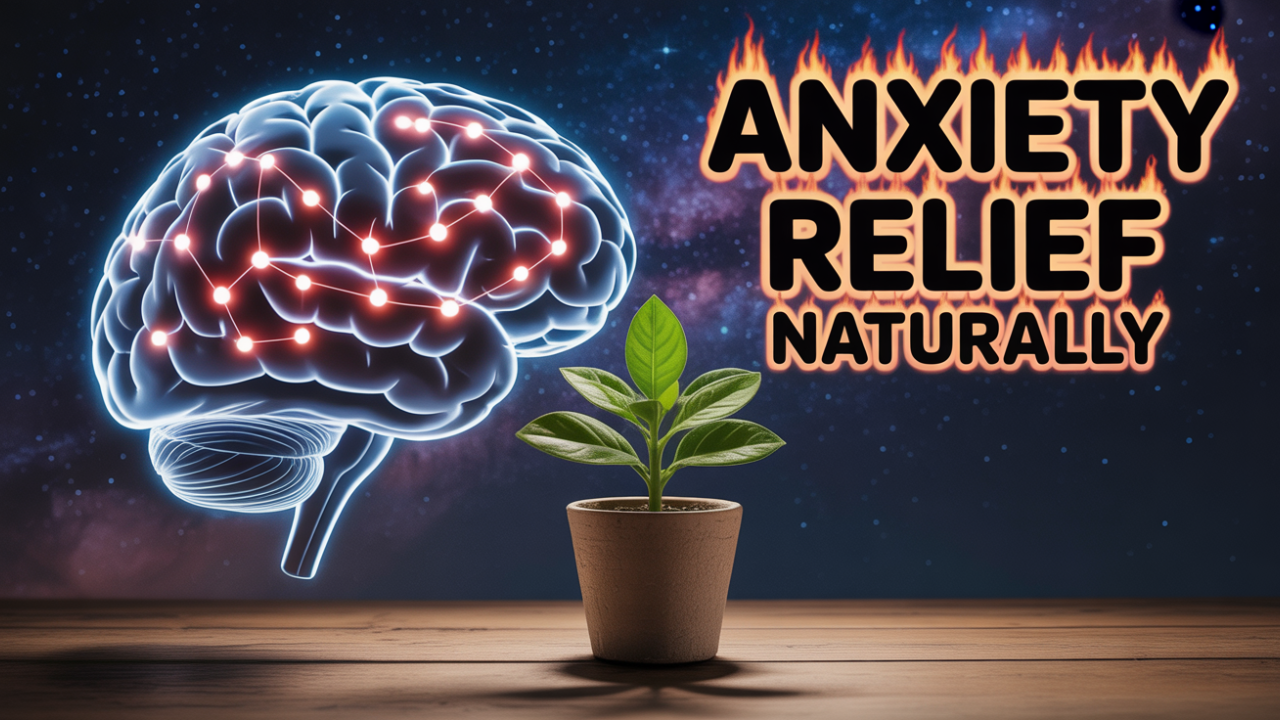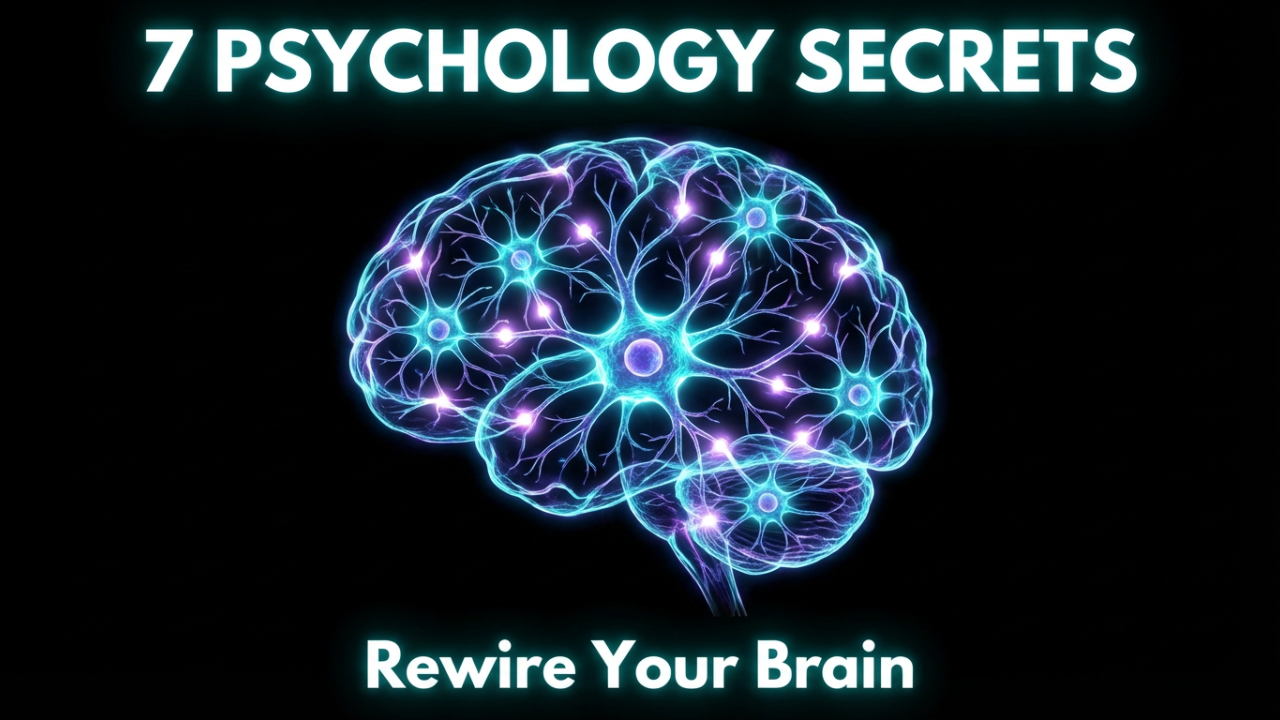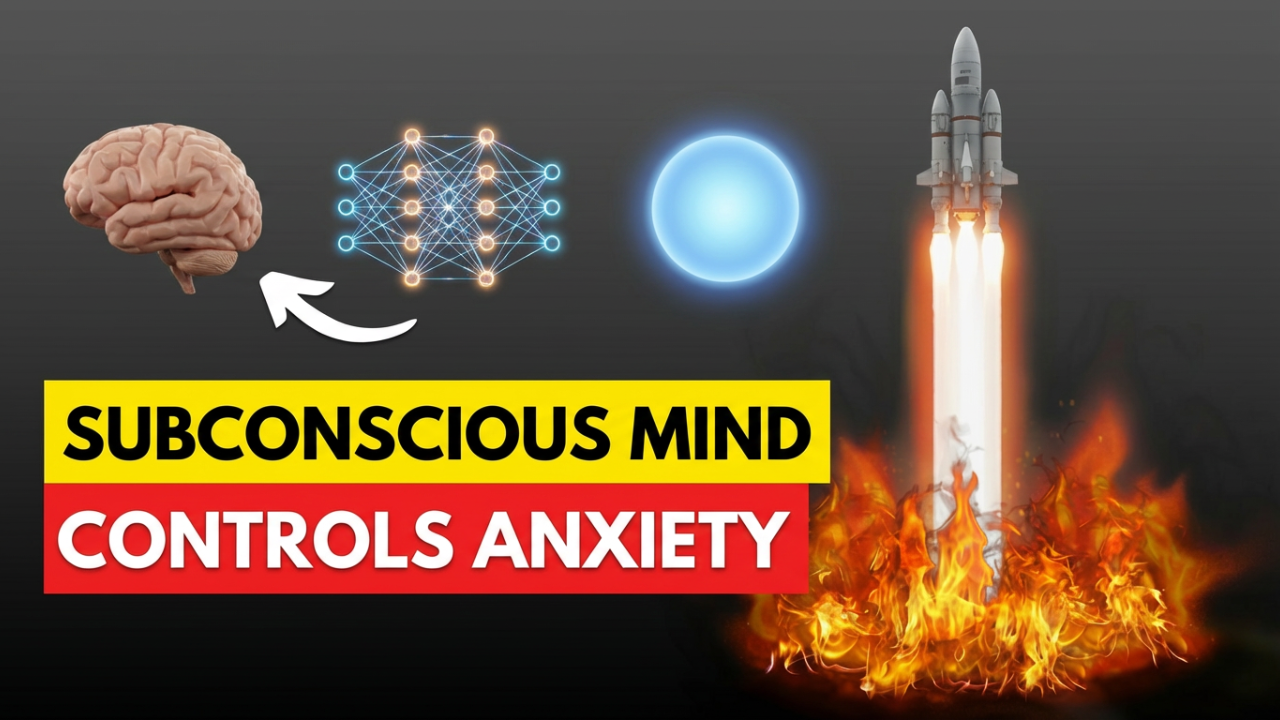You know that feeling—the racing heart, the worries that loop over and over, the sense that your brain is just stuck on a track of fear? What if you didn’t have to just live with that? What if I told you your anxiety isn’t a permanent state of being, but a pattern your brain has learned? And just like any pattern, it can be unlearned, and a new one can be put in its place.
This isn’t just wishful thinking; it’s neuroscience. In this article , we’re going to break down the practical, daily habits that can fundamentally change your brain’s response to stress and worry. You’ll learn how simple, consistent actions can tap into your brain’s own incredible ability to change—a concept called neuroplasticity—to build a calmer, more resilient mind.
We’ll explore the science-backed strategies and the “how-to’s” that put you back in the driver’s seat of your own mind. We’re not talking about quick fixes or ignoring the problem. We’re talking about a real rewiring process. By the end of this article , you won’t just understand the ‘what’ and the ‘why’ of your anxiety; you’ll have a complete toolkit of ‘how’ to start creating lasting change, today.
This book is scientific documentary of the Kingdom of God.
**(Section 1: The Anxious Brain – A User’s Guide)**
Before we can start rewiring the brain, we need to understand the current wiring. Why does anxiety feel so automatic, so powerful, and so out of our control? The answer is in a few key parts of your brain and how they’ve been trained to talk to each other.
Think of your brain as having a highly advanced, but sometimes overly sensitive, security system. The main control panel is a small, almond-shaped region called the amygdala. The amygdala is your emotional command center, and its primary job is to scan for threats. It’s your internal smoke detector, constantly sniffing the air for any sign of danger. When it senses a threat—whether it’s a car swerving into your lane, or a social threat like an upcoming presentation—it sounds the alarm.
This alarm triggers the famous “fight-or-flight” response. Your amygdala sends an emergency broadcast that floods your body with stress hormones like adrenaline and cortisol. Your heart pounds, your breathing gets shallow and rapid, and your senses go on high alert. This is a brilliant survival mechanism designed to help you fight off a predator or run for your life.
The problem in our modern world is that the “predators” are usually deadlines, financial worries, social pressures, and negative self-talk. But your amygdala doesn’t always know the difference. To it, a threat is a threat, and it pulls the same alarm lever every single time. In a person with chronic anxiety, this smoke detector has become hypersensitive. The sensitivity dial is turned all the way up, so even a tiny puff of smoke—like a vague email from your boss—can trigger a full-blown response. It learns to associate more and more things with danger, creating a state where you’re always on the lookout for what could go wrong.
Now, your brain also has a “CEO” that’s supposed to manage this smoke detector. This is your prefrontal cortex, located right behind your forehead. The prefrontal cortex is where your rational thought, logic, and decision-making come from. Its job is to look at the situation calmly and say, “Okay, smoke detector, I hear you. But I’ve checked it out, and it’s just burnt toast, not a house fire. You can stand down.” This top-down control is crucial for regulating our emotions.
In a well-balanced brain, the prefrontal cortex and the amygdala are in constant communication. The amygdala sounds the alarm, and the prefrontal cortex evaluates and calms it down if needed. But with chronic stress and anxiety, this relationship breaks down. The constant alarms from the overactive amygdala weaken the prefrontal cortex’s ability to do its job. Imagine a fire alarm in a building going off every ten minutes for no reason. Eventually, the building manager might start to have trouble getting it to shut off.
This creates a vicious cycle. The amygdala becomes more reactive, while the prefrontal cortex becomes less effective. The neural pathways that carry the “fear” signal become like multi-lane superhighways—wide, paved, and incredibly fast. Your brain gets really good at being anxious because it’s the path of least resistance. Meanwhile, the pathways for calm and rational thought become like overgrown dirt tracks. This is why anxiety can feel so automatic—your brain has literally been shaped by these repeated experiences. You’re not weak or broken; your brain has simply learned a very effective, but painful, survival strategy that is now misfiring in your daily life.
**(Section 2: Neuroplasticity – Your Brain’s Superpower for Change)**
Now that we get how the brain can get stuck in an anxiety cycle, let’s talk about the most hopeful concept in all of neuroscience: neuroplasticity. For a long time, people believed the adult brain was more or less fixed. We now know that’s completely untrue. Neuroplasticity is the brain’s lifelong ability to reorganize itself by forming new connections in response to our experiences, our learning, and even our thoughts.
Think of your brain not as a static piece of hardware, but as something dynamic, like clay. It can be molded and reshaped. Every time you think a thought, feel an emotion, or take an action, you strengthen the brain circuits for it. The pathways in your brain aren’t fixed roads; they’re more like paths in a dense forest. The more you walk down a particular path, the wider and easier it becomes to travel.
If you constantly walk down the path of worry and fear, that path becomes a well-worn trail, your brain’s default route. That anxiety superhighway we talked about was built exactly this way. But the incredible news is that you can choose to stop walking down that path. You can start blazing a new one.
At first, creating a new path—let’s call it the “path of calm”—is tough. You have to push through thick undergrowth. It’s slow, it takes effort, and it’s tempting to just jump back onto the easy, familiar anxiety highway. But every time you consciously choose this new path, you trample down a bit more of the brush. You make it a little clearer. Meanwhile, the old anxiety path, from disuse, slowly begins to get overgrown. It becomes less accessible, less automatic.
This is the core idea of how we overcome anxiety naturally. We aren’t just managing symptoms; we’re actively taking part in the renovation of our own brains. We do this by intentionally and repeatedly choosing thoughts and behaviors that build and reinforce new, healthier neural pathways. We can literally strengthen the prefrontal cortex—our brain’s CEO—so it gets better at managing the amygdala. We can even decrease the reactivity of the amygdala itself, effectively turning down the sensitivity on our internal smoke detector.
This isn’t a quick process. It’s like building muscle at the gym. You don’t see a change after one workout, but with consistency, the changes are undeniable and lasting. The daily habits we’re about to cover are your “workouts” for the brain. They are the tools you’ll use to systematically carve out those new pathways for calm and resilience, using your brain’s own innate superpower for change. You get to be the architect of your own mind.
**(Section 3: Habit 1 – Move Your Body to Change Your Mind)**
If there’s one single, powerful tool you can use to start rewiring your brain away from anxiety, it’s physical exercise. This is more than just “blowing off steam.” Regular physical activity fundamentally alters your brain’s chemistry and structure in a way that builds profound resilience to stress.
First, the immediate effects. When you exercise, especially aerobic exercise, your body releases a flood of powerful neurochemicals. You’ve heard of endorphins, the body’s natural mood elevators that create a “runner’s high.” But that’s just the start. Exercise also boosts serotonin, dopamine, and norepinephrine—neurotransmitters that are often the targets of antidepressant medications. This chemical shift can bring quick relief from anxious feelings.
But the real magic for rewiring the brain lies in the long-term effects. The most important player here is a protein called Brain-Derived Neurotrophic Factor, or BDNF. Think of BDNF as “Miracle-Gro” for your brain. It’s a powerful substance that promotes the birth of new brain cells and helps your existing ones form stronger connections, which is the very essence of neuroplasticity.
And where does BDNF have its biggest impact? Two key areas for anxiety: the hippocampus and the prefrontal cortex. Chronic stress actually causes the hippocampus—a region critical for emotional regulation—to shrink. But exercise is one of the most powerful ways to stimulate BDNF in the hippocampus. Studies have shown that regular aerobic exercise can actually increase its size, effectively reversing damage from stress. One study showed a 2% increase in hippocampal volume in a year, which is like reversing one to two years of age-related brain atrophy. By growing your hippocampus, you are literally building a stronger brain region dedicated to calming the fear response.
Exercise also strengthens your prefrontal cortex, your brain’s CEO. It improves blood flow and communication lines between the prefrontal cortex and the amygdala, strengthening that “top-down” control. This means your CEO gets better at calming down the hypersensitive smoke detector when it misfires.
So, what does this look like in practice? The goal is consistency over intensity. Research suggests 30 to 45 minutes of moderate-intensity aerobic exercise, three to five times a week, is a great target. Moderate intensity means you can still talk, but you’re breathing noticeably harder.
* **Aerobic exercise** is key. Think brisk walking, jogging, cycling, swimming, or dancing.
* **Strength training** is also great. It helps regulate blood sugar and reduce inflammation, which can both influence anxiety.
* **Yoga** is a fantastic hybrid, combining movement with the breathwork and mindfulness we’ll talk about next.
* **Move outdoors if you can.** Combining movement with nature has been shown to amplify the mental health benefits.
The most important thing is to start where you are. If 30 minutes seems impossible, start with a 10-minute brisk walk. That short walk can still make a noticeable difference. The key is to build a consistent habit. Don’t think of it as a chore. Reframe it: this is the time you dedicate each day to actively rebuilding your brain.
**(Section 4: Habit 2 – The Practice of Intentional Stillness: Mindfulness)**
While exercise works from the body up, our next habit works from the mind down. This is the practice of mindfulness. In our constantly-on world, the idea of intentional stillness might seem radical, but it’s one of the most direct ways to rewire the anxious brain.
At its core, mindfulness is simply paying attention to the present moment on purpose, without judgment. It’s not about “clearing your mind” or stopping your thoughts—that’s impossible. It’s about changing your *relationship* with your thoughts. For someone with anxiety, the mind often feels like a battlefield. Mindfulness offers a totally different approach: just observing.
Let’s go back to our brain analogy. Anxiety is often driven by a hyper-reactive amygdala (the smoke detector) and an under-powered prefrontal cortex (the CEO). Mindfulness directly addresses this imbalance. Brain imaging studies have shown that consistent meditation can lead to incredible structural changes.
First, it strengthens the prefrontal cortex. When you practice mindfulness, you’re flexing the “muscles” of attention and focus. Over time, this leads to an increase in grey matter density in this region. It’s like upgrading your brain’s CEO.
At the same time, mindfulness has a remarkable effect on the amygdala. Studies show that after an 8-week mindfulness program, the grey matter in the amygdala actually *decreases*. It shrinks, which is linked to lower stress and a less reactive fear center. You’re effectively turning down the sensitivity of your internal smoke detector.
Mindfulness also improves the functional connection between these two areas, allowing your upgraded CEO to have a more calming influence over your less reactive smoke detector. This neuroplastic change means the calm, measured response starts to become more automatic.
So how do you practice this? It’s incredibly simple. Here is a 5-minute mindfulness of breath exercise you can do right now:
1. **Find a comfortable position.** Sit in a chair, feet flat on the floor, with an upright but relaxed posture.
2. **Gently close your eyes** or just lower your gaze.
3. **Bring your attention to your breath.** Don’t try to change it. Just notice it. Feel the air coming in, filling your lungs. Feel the rise and fall of your chest. Just rest your awareness on the physical sensations.
4. **Your mind will wander.** This is not a mistake; it’s what minds do. When you notice your mind has wandered to your to-do list or a worry, gently, without judgment, just acknowledge it (“ah, thinking”) and then softly guide your attention back to your breath.
5. **Repeat this process.** Just continue this cycle. Breath. Mind wanders. Notice. Gently return. This “returning” is the whole practice. Every time you guide your mind back, you’re doing a bicep curl for your prefrontal cortex. You are strengthening that muscle of attention.
That’s it. Even 5-10 minutes a day can make a huge difference. The goal isn’t a perfectly still mind. The goal is to practice noticing when you get carried away by thought and gently bringing yourself back. By doing this, you create a small gap between a trigger and your reaction. In that gap lies your power to choose a different response. You learn to see your thoughts as just thoughts—passing events in the mind—not absolute truths.
**(Section 5: Habit 3 – Become the Architect of Your Thoughts: Cognitive Reframing)**
Our first two habits work on the body and our attention. Our third habit targets the very content of your anxiety: your thoughts. Cognitive reframing, a cornerstone of Cognitive Behavioral Therapy (CBT), is the practice of identifying, challenging, and changing the unhelpful thought patterns that fuel anxiety. CBT is highly effective for many people with anxiety because it’s a direct way to practice neuroplasticity.
Remember our “path in the forest” analogy? Anxious thoughts are those well-worn, automatic pathways. Cognitive reframing is the manual process of carving a new path. It’s about learning to become a detective of your own mind, questioning the automatic negative thoughts that pop up and go unexamined.
You can break it down into a simple, three-step method: Catch It, Check It, Change It.
**Step 1: Catch It – Identify the Anxious Thought**
The first step is simply to become aware of the specific thoughts causing your distress. Anxious feelings don’t come from nowhere; they’re almost always kicked off by a thought. You need to learn to “catch” these thoughts.
Let’s say you have to give a presentation next week and you feel a surge of anxiety. Pause. Ask yourself: “What, specifically, is going through my mind?” You might “catch” a thought like: “I’m going to mess this up completely. Everyone will think I’m incompetent.” Write it down. Getting the thought out of your head and onto paper makes it easier to examine objectively.
**Step 2: Check It – Challenge the Thought**
This is where you put on your detective hat. Thoughts are not facts. Your job is to examine the evidence for and against this thought, like a lawyer in a courtroom. Ask yourself:
* **What’s the evidence this thought is true? What’s the evidence it’s *not* true?**
* *For the presentation thought:* “Evidence it’s true: I feel nervous. Evidence it’s *not* true: I’ve given presentations before that went fine. I’m prepared. My boss has given me positive feedback in the past.”
* **Am I falling for any unhelpful thinking styles?**
* **Catastrophizing:** Am I jumping to the worst possible conclusion? (“I’ll be fired if I stumble over a word.”)
* **Black-and-White Thinking:** Am I seeing it as all-or-nothing? (“If it’s not a perfect presentation, it’s a total failure.”)
* **Mind Reading:** Am I assuming I know what others are thinking? (“Everyone will think I’m an idiot.”)
* **What’s a more realistic outcome?**
* “Realistically, I’ll probably be nervous at the start, but I’ll get through it. Some people might find it interesting, and most will forget about it by the next day.”
* **If the worst-case scenario happened, could I handle it?**
* “If I did freeze up, it would be embarrassing, but I wouldn’t die. I could apologize, take a sip of water, and look at my notes. People are generally more forgiving than I think.”
**Step 3: Change It – Replace the Thought**
Once you’ve cross-examined the thought, create a more balanced and realistic alternative. This new thought isn’t blind positivity; it has to be believable to you.
* **Original Anxious Thought:** “I’m going to mess this up completely. Everyone will think I’m incompetent.”
* **Balanced, Reframed Thought:** “I’m nervous about the presentation, and that’s normal. I’m prepared, and I can do a good job. Even if I make a small mistake, it’s not a catastrophe, and I can handle it.”
Every time you go through this “Catch It, Check It, Change It” process, you are actively choosing not to go down that old anxiety superhighway. You’re blazing your new path of calm, rational assessment. You are weakening old connections and building new ones. With practice, the balanced thoughts start to become more automatic. You are, quite literally, changing your mind.
**(Section 6: Habit 4 – Stimulate Your Brain with Novelty and Learning)**
The brain loves novelty. Engaging in new, challenging activities is a powerful way to stimulate neuroplasticity and build a more flexible, resilient brain. When you learn a new skill, you force your brain to create entirely new neural pathways, which helps counterbalance the rigid, looping circuits of anxiety.
Think of it this way: an anxiety cycle is like running the same old software program over and over. The worries are the same, the fears are the same. Learning something new is like installing fresh software. It demands your full attention, engages different parts of your brain, and provides a healthy focus away from worry.
The key is that the activity should be new to you and require focused attention. Just doing a slightly different version of something you’re already good at won’t have the same effect. According to neuroscientist Dr. Andrew Huberman, this focused struggle is what opens up the brain to change.
This process builds what’s called “cognitive reserve.” By building a rich network of neural connections, you’re creating a denser, more interconnected brain. This means if one pathway (like an anxiety pathway) becomes overactive, your brain has plenty of other routes to take. It makes your mind more flexible and less likely to get “stuck.”
What kind of activities work best? The options are endless, but choose something you find genuinely interesting, so you’ll stick with it.
* **Learn a new language:** This engages memory, sound processing, and pattern recognition. Apps like Duolingo make it easy to start.
* **Learn a musical instrument:** This is a full-body workout for the brain, integrating sound, fine motor skills, and memory.
* **Try creative arts:** Painting, pottery, or creative writing engage different brain areas and allow for non-verbal expression.
* **Pick up a skill-based hobby:** This could be coding, gardening, woodworking, or cooking complex new recipes.
* **Play brain-training games:** Puzzles, crosswords, Sudoku, or strategy games force you to think in new ways.
* **Explore new physical skills:** Try a new sport, a dance class, or rock climbing. Learning complex new movements is fantastic for the brain.
Even something as simple as taking a different route on your daily walk can help. When you travel through new territory, your brain has to create new maps, which promotes a state of readiness for plastic change.
The goal isn’t to become a master overnight. The goal is the *process* of learning. It’s about embracing being a beginner, making mistakes, and slowly improving. By proving to yourself that you can learn a new chord on the guitar, you’re also reinforcing the belief that you can learn new ways of responding to anxiety.
**(Section 7: Habit 5 – The Science of Savoring and Gratitude)**
Our final habit is a subtle but profound practice that directly counters one of the brain’s most frustrating tendencies: the negativity bias. For our ancestors’ survival, it was far more important to remember the one time they saw a lion near the watering hole than the hundred times they didn’t. Our brains are therefore wired to be like Velcro for negative experiences and Teflon for positive ones. They scan for threats and lock onto them.
This bias is a major engine for anxiety. The practice of savoring and gratitude is an intentional training exercise to counteract this. It’s not about pretending everything is perfect; it’s about deliberately shining a spotlight on the good that already exists, forcing your brain to register and remember it.
**Savoring** is the practice of consciously paying attention to a pleasant experience. It’s mindfulness for positive moments. Think about your morning cup of coffee. Instead of gulping it down while scrolling on your phone, savoring it means:
* Noticing the warmth of the mug.
* Inhaling the aroma.
* Taking the first sip and paying full attention to the taste.
* Lingering in that simple, pleasant sensation for a few extra seconds.
By doing this, you’re telling your brain, “This is important. Remember this feeling.” You are strengthening the neural pathways for pleasure and contentment.
**Gratitude** works in a similar way. A simple, powerful way to practice is with a daily gratitude journal. Every evening, write down three specific things that went well that day and your role in making them happen.
For example, instead of a generic “I’m grateful for my family,” you might write:
1. “I’m grateful for the funny conversation I had with my sister today. I made the effort to call her, and it lifted my spirits.”
2. “I’m grateful my boss appreciated my report. I worked hard on it, and it felt good to have that recognized.”
3. “I’m grateful for the beautiful sunset I saw. I chose to take the scenic route home, and it was a moment of unexpected calm.”
This does two things. First, it forces you to scan your day for positives, fighting the negativity bias. Second, by noting your role, you reinforce your sense of self-efficacy—a powerful antidote to the helplessness of anxiety.
Another great technique, suggested by Dr. Huberman, is to reflect on times when your worries didn’t come true. By consciously recalling moments when you were anxious about something that turned out fine, you train your brain to focus more on safety and calm, not just fear. This helps recalibrate the amygdala’s threat detector. With consistency, you are training your brain to notice and prioritize positive information, making your mind a place where peace can reside.
**(Conclusion)**
We’ve explored how the anxious brain works, not as passive observers, but as active architects. We’ve learned that anxiety is not a life sentence. It is a pattern etched into neural pathways—pathways that you can change. Your brain’s incredible capacity for neuroplasticity is the key, and the daily habits we’ve discussed are the tools.
Let’s quickly recap your rewiring toolkit:
1. **Move Your Body:** Exercise boosts mood-regulating chemicals and releases BDNF, the “Miracle-Gro” for your brain, to physically rebuild regions damaged by stress.
2. **Practice Mindfulness:** Just a few minutes a day strengthens your prefrontal cortex, calms your reactive amygdala, and teaches you to observe your thoughts without being consumed by them.
3. **Use Cognitive Reframing:** The “Catch It, Check It, Change It” method helps you dismantle anxious thoughts and build new, more balanced neural pathways.
4. **Learn Something New:** By challenging your brain with novelty, you build cognitive reserve and make your mind more flexible and less likely to get stuck in anxious loops.
5. **Practice Savoring and Gratitude:** You can actively fight your brain’s negativity bias by deliberately focusing on and encoding positive experiences, training your mind to find safety and contentment.
None of these habits is a magic bullet. They are skills. And like any skill, they require practice and patience. There will be days when it feels hard, when you fall back into old patterns. That’s okay. The goal isn’t perfection; it’s persistence. Every time you choose to take a walk, to sit in stillness, or to challenge a thought, you are casting a vote for a new you. You’re laying another stone on your new path to calm.
You have the power to change your brain. The journey begins not with a giant leap, but with a single, small step, repeated day after day. You are the architect. Start building today.







